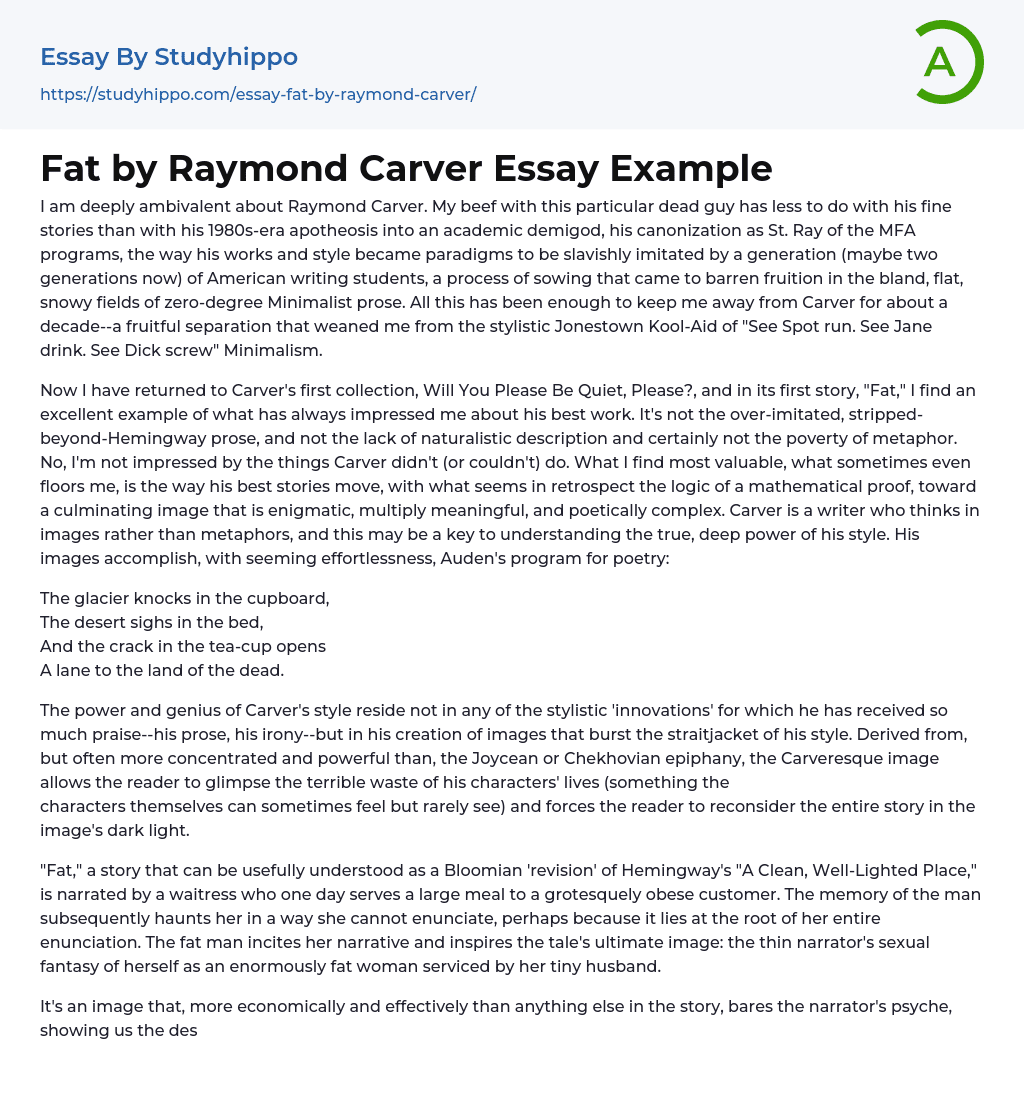I have mixed feelings about Raymond Carver. Despite his excellent stories, my issue lies with his rise to prominence in academia during the 1980s. He was revered as a saintly figure in MFA programs, and countless American writing students imitated his works and writing style tirelessly. This ultimately led to a landscape of unoriginal and dull minimalist prose that dominated for two generations. Consequently, I have refrained from engaging with Carver's work for the past decade. This break has been valuable as it allowed me to distance myself from the stylistic conformity prevalent in minimalist writing at that time.
Returning to Carver's first collection, "Will You Please Be Quiet, Please?", I am struck by an exemplary instance of what has always impressed me about his finest work in the opening story, "Fat". It
...is not the excessively imitated, Hemingway-esque prose, nor the absence of realistic description, and certainly not the scarcity of metaphors that leave me in awe. No, I am not awed by what Carver did not (or could not) accomplish. What I truly value, and at times am even astounded by, is the way his greatest stories progress with a retrospectively logical flow – almost akin to a mathematical proof – towards a culmination of an enigmatic, multifaceted, and poetically intricate image. Carver is a writer whose thoughts are composed of images rather than metaphors, and this might hold the key to comprehending the genuine and profound potency of his style. His imagery achieves, seemingly effortlessly, Auden's vision for poetry:
The glacier in the cupboard collides,
The desert in the bed breathes deeply,
And the crack in the tea-cup creates
pathway to the realm of the deceased.
Carver's style is not distinguished by the stylistic 'innovations' he is praised for, like his prose and irony. Instead, it lies in his creation of images that surpass the limitations of his style. These images, reminiscent of but stronger than the epiphanies found in Joyce or Chekhov, reveal the tragic futility of Carver's characters' lives, a truth that the characters themselves occasionally sense but seldom fully recognize. The presence of these dark images compels readers to reevaluate the entire story.
The story "Fat" can be seen as a revision of Hemingway's "A Clean, Well-Lighted Place," according to Bloom. It is narrated by a waitress who serves a huge meal to a remarkably obese customer. The memory of this man continues to trouble her, as it seems to be at the core of her entire expression. The fat man stimulates her storytelling and leads to the ultimate image in the story: the thin narrator's sexual fantasy of being an extremely fat woman with her small husband servicing her.
The narrator's psyche is revealed through an image in the story, showcasing a combination of passivity and aggression that reflects their despair. Additionally, this image causes a shift in readerly identification from the narrator to Rita, the clueless listener. As a result, both the reader and Rita are left confused at the end of the story, uncertain about how to interpret the supposedly "funny" story that lacks humor entirely.
- Book Summary essays
- Metaphor essays
- Reader essays
- Rhyme essays
- Literary devices essays
- Villain essays
- Books essays
- Genre essays
- Literary Criticism essays
- Writer essays
- Protagonist essays
- Simile essays
- Poem essays
- Book Report essays
- Book Review essays
- Greek Mythology essays
- Plot essays
- Tragic Hero essays
- Coming of Age essays
- Play essays
- Rhetoric essays
- Rhetorical Question essays
- Translation essays
- Understanding essays
- Reason essays
- Character essays
- Letter essays
- American Literature essays
- Literature Review essays
- Utopia essays
- Poetry Analysis essays
- Dante's Inferno essays
- Between The World and Me essays
- Incidents in The Life of a Slave Girl essays
- Flowers for Algernon essays
- Myth essays
- Everyday Use essays
- Boo Radley essays
- Genesis essays
- Richard iii essays
- Alice in Wonderland essays
- On the road essays
- Ozymandias essays
- The Nightingale essays
- Holden Caulfield essays
- Animal Farm essays
- 1984 essays
- A Hanging essays
- Shooting An Elephant essays
- A Tale Of Two Cities essays




